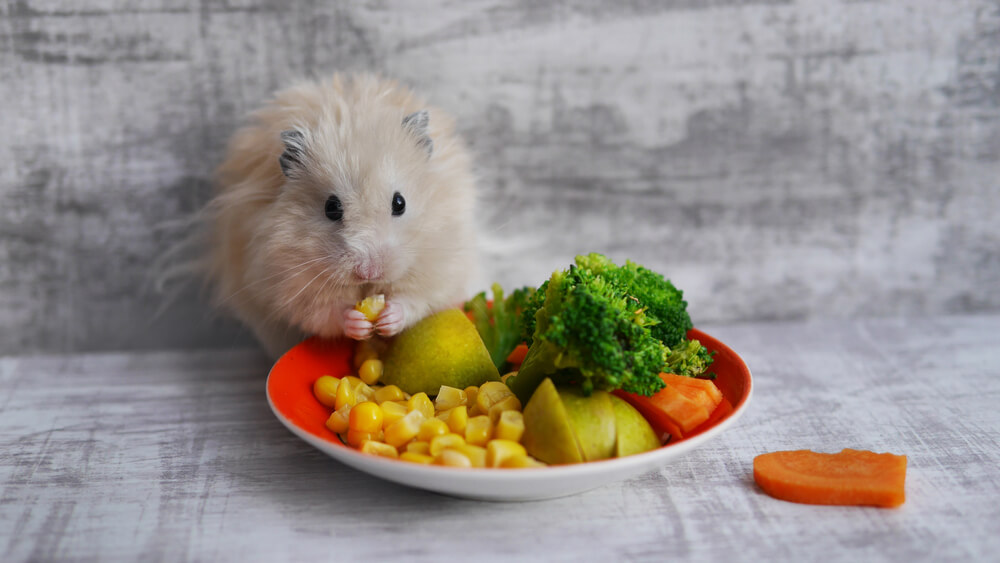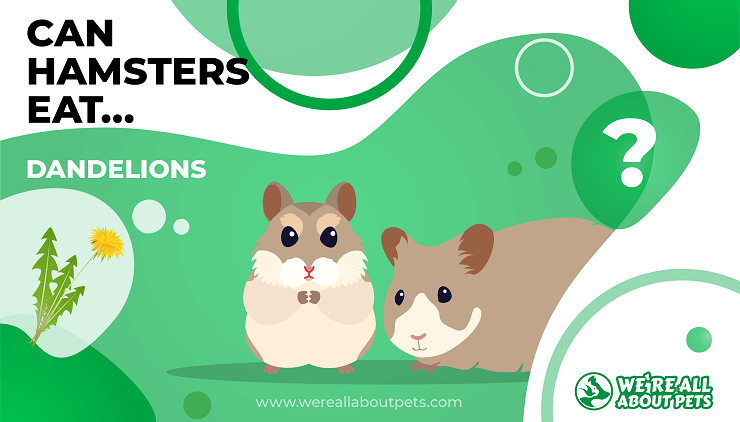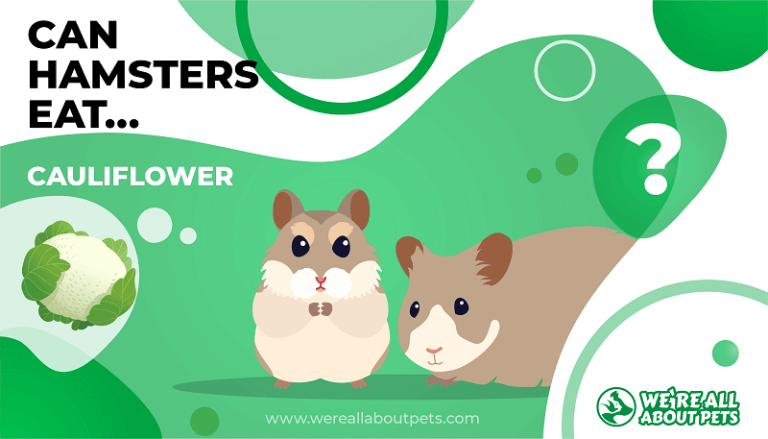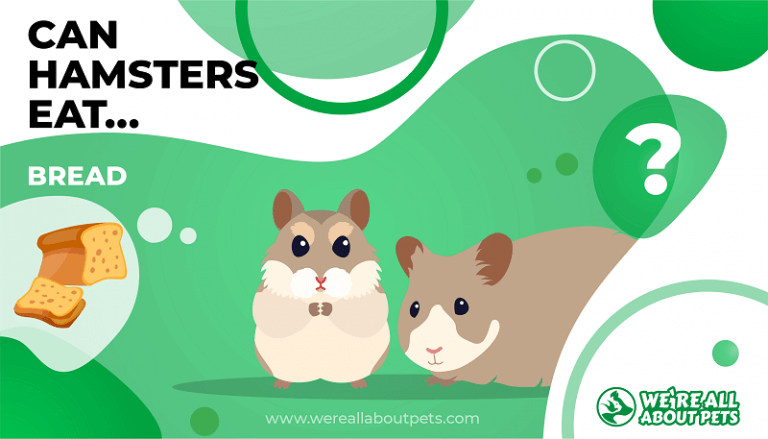What Do Hamsters Eat?
This page contains affiliate links. We may earn money or products from the companies mentioned in this post through our independently chosen links, which earn us a commission. Learn More
Small animals like hamsters make wonderful pets. They don’t require as much as space as cats or dogs, and they are less of a time commitment as well.
That being said, you still need to meet your hamster’s basic needs if you want it to be happy and healthy – this includes feeding it a balanced diet.
There are three common types of hamsters kept as pets: Syrian hamsters, dwarf hamsters (Roborovski hamsters), and Chinese hamsters.
When you head to the pet shop to pick out your new pet, you should have an understanding of the differences and what each type of hamster needs in terms of diet.
Generally speaking, hamsters don’t require a lot of food but that just makes it all the more important that you feed your hamster the right things.
Feeding your furry friend well will ensure that it lives as long as possible.
When fed properly, hamsters can live anywhere from 1.5 to 3 years. Read on to learn the basics about what you can and cannot feed your pet hamster and to learn more about its nutritional needs.
Quick Navigation
Safe and Unsafe Vegetables, Fruits and Human Foods for Hamsters

Small animals have different food requirements than dogs and cats. Are you wondering what to feed hamsters? We’ve assembled a list of dozens of foods that are and aren’t safe for your pet hamster. Check them out below!
20 Foods That Are Safe for Hamsters:
To meet your hamster’s nutritional needs, you should feed a high-quality, commercial balanced diet. In addition to that food, however, you can give your hamster treats such as the following:
- Apples
- Bananas
- Blueberries
- Raspberries
- Blackberries
- Broccoli
- Carrots
- Cauliflower
- Dandelion greens
- Grapes
- Kale
- Peas
- Potato (cooked)
- Romaine lettuce
- Spinach
- Strawberries
- Sweet potato
- Kale
- Hay
- Fresh herbs
10 Foods Hamsters Can Eat in Moderation:
Though fruits, vegetables, and herbs make the best treats for hamsters, you can also feed small amounts of certain other foods. These should only be offered as occasional treats:
- Boiled egg
- Nuts
- Mealworms
- Crickets
- Brown rice (cooked)
- Cooked chicken
- Pumpkin seeds
- Lentils
- Sunflower seeds
- Air-popped popcorn
7 Foods That Are Not Recommended for Hamsters:
Though hamsters will eat just about anything, some foods are not recommended. Avoid processed foods intended for human consumption because they may contain too much sugar or other food additives. Foods not recommended for hamsters include:
- White pasta
- White bread
- Breakfast cereal
- Muesli
- Citrus fruits
- Salted nuts
- Foods with high sugar content
10 Foods That Are Toxic for Hamsters:
When feeding your hamster fresh food, you need to be careful about including the seeds. Though sunflower seeds and pumpkin seeds are perfectly safe, apple seeds are not. Here are some foods that are dangerous or toxic for hamsters:
- Apple seeds
- Raw potatoes
- Raw beans
- Almonds
- Citrus fruits
- Garlic
- Onions
- Rhubarb leaves
- Raw rhubarb
- Chocolate
Understanding which foods are and are not safe for your hamster is very important, but you also need to understand your hamster’s nutritional requirements if you want it to be healthy. Read on to learn the specifics of what to feed your hamster at different ages.
Types of Hamster Diets
Wild hamsters follow a varied diet of seeds, grains, nuts, fruit, and vegetables. They may also feed on insects, small lizards, and even other small animals. In captivity, a hamster’s diet should consist of at least 16% protein and 5% fat and it should be made up of a variety of foods.
Here is a quick breakdown of the different components of a pet hamster’s diet:
- Commercial Pellets – What hamster owners need to remember is that their pet has specific nutritional needs and the best way to make sure those needs are met is with a commercial pellet. Avoid muesli mixes that contain more seeds than fiber – your hamster will pick them out.
- Seed Mixes – Though commercial pellets should be the staple of your hamster’s diet; you can offer healthy seed mixes or seed mixes with whole grains to add variety to the diet.
- Fresh Food – Fresh vegetables and small amounts of fresh fruit can be offered daily to boost your hamster’s nutrition and to add variety to the diet as well.
- Treats – Avoid yogurt drops and other commercial treats because they often have high sugar content. Instead, offer your hamster dried insects or a little boiled egg or chicken.
Now that you know what kinds of foods will make up your hamster’s diet, you’re probably curious to know how much to feed it. Keep reading to learn about feeding recommendations for pet hamsters.
Meeting Your Pet Hamster’s Nutritional Needs
The hamsters you see in the pet store should be old enough to eat pelleted commercial food as well as fresh vegetables and fruits.
If you have a pregnant hamster and find yourself caring for the pups, you may need to feed them a mixture of evaporated milk and water if the mother stops feeding them.
The thing hamster owners need to remember is that hamster like to hoard – they stuff as much food as they can into their cheek pouches.
It is important not to overfeed the hamster or it may become obese which increases its risk for various health problems.
Only offer your hamster as much fruit and vegetables as it can consume in a few hours – if you provide enough for the hamster to hoard it could rot in the cage. You really only need to offer veggies every other day and fruits about once a week.
To give you an idea what and how much you should be feeding your pet hamster in different stages of life, refer to this chart:
Daily Hamster Feeding Chart |
||||
| Age | Breed | Staple Diet | Veggies and Fruit | Treats |
| Baby | Any | Evaporated milk mixed 50/50 with water fed by syringe | Small amount of broccoli | Wheat germ cereal, millet seeds, sprig of millet |
| Adult | Syrian | 1 ½ to 2 ½ tablespoons pellets daily (fill bowl about ¾ full) | Dark leafy greens every other day, fruits once a week | Alfalfa/timothy hay or whole grains twice a week |
| Adult | Dwarf | 1 to 2 tablespoons pellets daily (fill bowl about ¾ full) | Dark leafy greens every other day, fruits once a week | Alfalfa/timothy hay or whole grains twice a week |
| Adult | Chinese | 1 to 2 tablespoons pellets daily (fill bowl about ¾ full) | Dark leafy greens every other day, fruits once a week | Alfalfa/timothy hay or whole grains twice a week |
In addition to providing your hamster with enough food, you also need to make sure it gets plenty of fresh water. Hang a water bottle in your hamster’s cage and make sure it stays full. You should clean and refill it once a day or every other day to keep it fresh.
Recommended Commercial Hamster Foods
Remember, a pelleted balanced diet should be the staple of your hamster’s feeding routine to make sure it gets the nutrients it needs in adequate amounts. Look for a product that contains at least 16% protein and 5% fat. As long as your hamster has commercial pellets for the majority of its diet, you can offer seed mixes as a treat to introduce a variety of foods into the diet.
Here are some of our top picks for the best commercial hamster food:
- Kaytee FortiDiet Pro Health Hamster Food – This hamster food contains a blend of nutritionally balanced pellets, seeds, and other healthy foods for your hamster to enjoy. Plus, it’s fortified with vitamins and minerals for nutritional balance.
- Tiny Friends Farms Hazel Hamster Tasty Mix – This formula is designed to support your hamster’s natural foraging behavior, so it contains a variety of foods with added vitamins to ensure optimal health and vitality.
- Oxbow Essentials Hamster & Gerbil Food – Made with hand-selected timothy hay and no artificial ingredients, this hamster food offers balanced nutrition in every bite.
Looking for more recommendations on what to feed your hamster? Check out our in-depth guide to the best commercial hamster foods.
Hopefully by now you understand the basics about feeding your pet hamster, but we understand if you still have a few questions. Here are the answers to some commonly asked questions about hamsters.
Hamster Feeding FAQs
What do hamsters eat in the wild?
Hamsters are omnivores which means that they eat a wide variety of foods in the wild. Wild hamsters will eat everything from seeds and grasses to insects and meat.
How much do hamsters eat?
Pet hamsters only require about 1 to 2 tablespoons of food per day. If you give them too much more, they will stuff it in their cheek pouches and hoard it somewhere in the cage. Feeding your hamster more than it can eat may also cause the hamster to pick out the pieces it wants, leaving the rest to go to waste. Only fill your hamster’s bowl about ¾ full and don’t refill it until it eats most of the food.
What do hamsters drink?
Hamsters drink water, so you should provide unlimited fresh water in the form of a water bottle. If you use a water bowl, it could become contaminated with food and bedding.
Do hamsters eat insects?
Yes, wild hamsters eat insects as part of their regular diet. Pet hamsters can enjoy dried crickets or mealworms as an occasional treat. Pellets should still be the staple of the diet.









